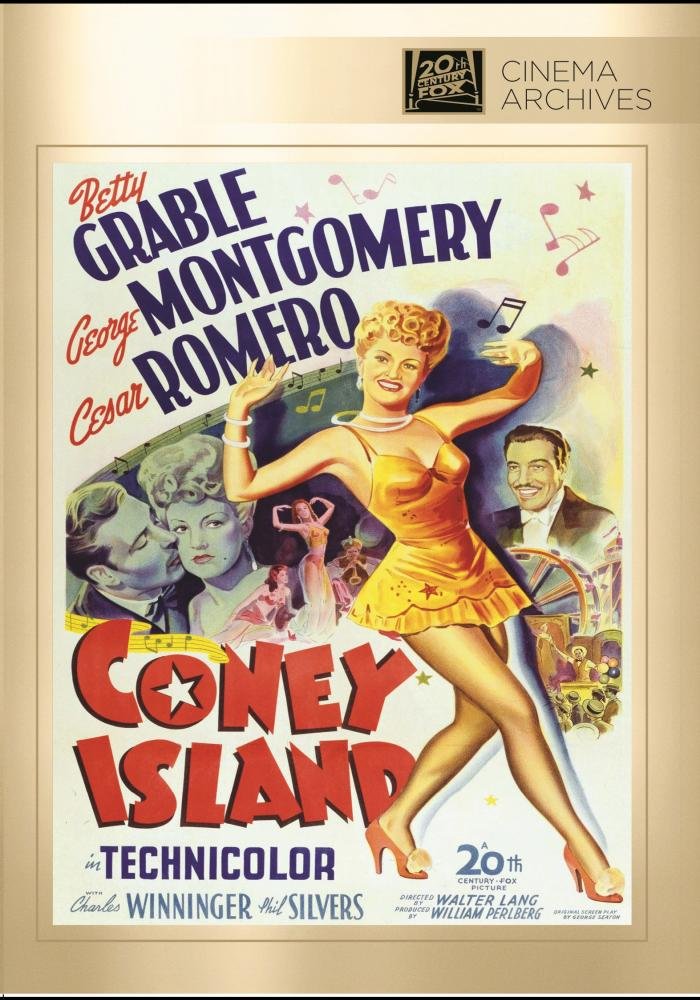
You’ve got to love a movie in which the opening titles are sung.
But crooned credits are just one reason to go gaga for Coney Island (1943), a buoyant backstage musical starring iconic World War II pin-up girl Betty Grable, on DVD for the first time from Fox Cinema Archives.
There are plenty of other delights to savor in this gorgeous “Gay Nineties” romp: bright and bold Technicolor cinematography by Ernest Palmer; Oscar-nominated musical direction from Alfred Newman (uncle to Randy, but no relation to Mad‘s gap-toothed mascot); ingenious choreography by the legendary Hermes Pan (who also performs); catchy original songs from Ralph Rainger and Leo Robin (the duo who penned “Thanks for the Memory,” Bob Hope’s career-spanning signature); and a stellar cast of stars from the Twentieth Century Fox stable.
And then there’s Betty Grable. The girl with the “million dollar legs” was the secret sweetheart of America’s fighting forces during the war years, and Fox’s first lady in the latter half of the ‘40s (after the acrimonious exit of singing star Alice Faye). But Grable was more than just the girl next door who won the war, she was a genuine triple threat: an actress with a charming screen presence; a sultry voiced vocalist; and, according to frequent co-star Dan Dailey, a “natural dancer” who could hold her own with the best in the business. All of those skills are on delightful display here, in a film from veteran director Walter Lang, who helmed everything from silent melodramas to big budget musicals like The King and I (1956) during his 36-year career.
Set in the East Coast beach resort sometime during the “Naughty” 1890s, Coney Island stars Grable as Kate Farley, a showgirl with a heart of gold (is there any other kind?) and an act as unrefined as her working-class clientele. Kate is the top attraction at Ocean Gardens, a rough-and-tumble burlesque house operated by mustachioed mobster Joe Rocco (Cesar Romero). Joe is sweet on his sexy star, but Kate has her eye on a handsome new face: Joe’s ex-partner Eddie Johnson (George Montgomery).
Eddie shows up in a sharp suit, with an axe to grind. There’s the little matter of a business deal settled two years ago with a dodgy deck of cards. But Joe’s got no intention of making good, so, with the help of harmonizing hustler Frankie (Phil Silvers) Eddie opens up a competing cooch joint with bogus “Turkish” beauties. Joe doesn’t appreciate the unexpected competition, and decides to teach Eddie a lesson.
“I know some guys in Brooklyn who are swell teachers,” Louie the bartender (Paul Hurst) offers.
Louie’s goons put the kibosh on Eddie’s ersatz Middle Eastern establishment and Eddie returns the favor with a manufactured melee and murder at the Ocean Gardens. Finnigan (Charles Winninger), the blarney-soaked victim, isn’t really deceased; he’s just drunk. But Eddie and Frankie fake his funeral (hilariously), and Eddie blackmails Joe into giving him a job running the variety shows at the club. Eddie’s first mission: to class up Kate’s act.
Conflict ensues, which quickly turns to canoodling, but Eddie’s Pygmalion routine works a bit too well and Kate eventually outgrows both of the boys on her way to Broadway stardom. That doesn’t stop Eddie and Joe from double-crossing each other all the way across the East River while Kate makes good on the Great White Way. Which one of these two handsome scoundrels will she choose? That’s pretty obvious from the fade-up, but it’s lots of fun to watch.
Coney Island is a delight, but it may have worked even better if the male leads had switched roles. Cesar Romero, best known today as The Joker on the 1960s Batman series, seems miscast as the less-than-smooth criminal Joe Rocco. A New York City native of Cuban descent, Romero frequently portrayed stylish Latin lovers, but here he’s a neighborhood thug with bad taste and no game. George Montgomery, a slightly stiff performer who often appeared in Westerns, might have been a better choice for Joe. Montgomery at times seems to be attempting an imitation of Clark Gable, who mastered the sexy, smirking lothario in a way Montgomery does not here.
The supporting player casting is impeccable, though, as was often the case with big budget musicals of the Studio Era. Phil Silvers, later to become TV’s Sgt. Bilko, makes the most of his fourth-banana role and provides the film’s single funniest moment, when he improvises a song to warn Eddie of Finnigan’s return from “the dead.” As the briefly deceased Irishman, Charles Winniger dominates every scene he’s in. His rendition of “Who Threw the Overalls in Mrs. Murphy’s Chowder” is just one example of the film’s excellent use of popular songs of the period (even though some may be anachronous).
Speaking of songs and styles of the era, there’s a blackface scene in Coney Island. Grable dons a dark wig and tan make-up for the “Miss Lulu from Louisville” sequence, with six white dancers in greasepaint and faux Afros supporting her. This can be off-putting to modern viewers, but blackface was a popular performance style during the era in which the film is set, and depicting it here is historically accurate. Grable herself was no stranger to the style. She appeared in blackface in the chorus in her film debut, Happy Days (1929). And her 1945 film The Dolly Sisters includes “The Darktown Strutter’s Ball,” a far more notorious number in which Grable and co-star June Haver dance in “pickaninny” costumes as back-up performers wear watermelons on their heads. That scene is also mitigated by its turn-of-the-century setting, but it’s admittedly shocking.
For more fun in the Naughty Nineties, pick up Wabash Avenue (also available from Fox Cinema Archives), the 1950 remake of Coney Island featuring Grable playing essentially the same character, only seven years older and with a different name. They don’t sing the credits in that one, but it’s still worth a look.